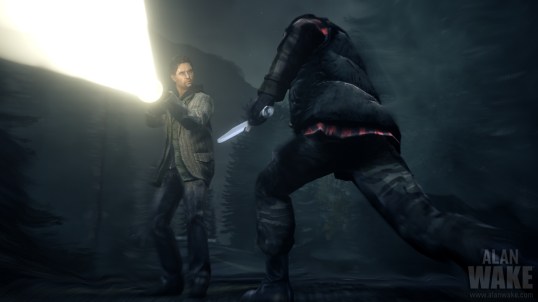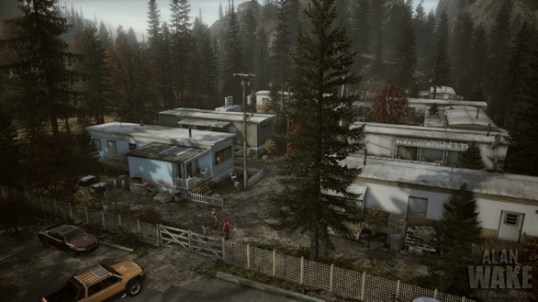Alan Wake
Publisher: Microsoft Game Studios
Developer: Remedy
Available on: May 18
Platform: Xbox 360
ESRB rating: M for Mature
System reviewed on: Xbox 360
Man, what happened to the horror game? The latest Silent Hill installments no longer pack the same surreal punch as they did in the past and Tecmo’s camera-based Fatal Frame games seem to have permanently faded from view. Sony’s Siren game on PS3 a few years back wasn’t all bad but failed to stir up much of an audience. The biggest scares of late have been offered in games that cross over into other genres like Dead Space or Bioshock. The genre needs a new standard-bearer. Though it’s being billed as a psychological action thriller, Alan Wake may just be the game to make players remember what a good fright feels like. Remedy Entertainment–most famous for the hard-boiled Max Payne shooters–has been cooking up Alan Wake for more than five years. Read on to see if it’s worth the wait.
What’s This All About, Now?: Alan Wake puts players in the role of the title character, a once-successful writer who’s been struggling with writer’s block for two years. His wife Alice convinces him that they should get away to the small town of Bright Falls in Washington State to relax. But she disappears after they argue about him writing again, and the game’s main plot is Alan’s desperate search for Alice. As you steer Alan through Bright Falls, the town’s occult secrets come to light, including the existence of malevolent force called the Dark Presence.
Hey, What Does This Button Do?: The gameplay in Alan Wake revolves around a really inventive light vs. shadow mechanic. The Dark Presence controls the townsfolk and turns them into shadowy servants called the Taken. Wake’s main weapon against them is light. Using a flashlight to burn the darkness off the Taken, you’ll then be able to blow them away with firearms. You’ll need to use battery pack like ammo clips to make sure your beam stays strong enough to keep the Taken at bay. With multiple baddies swarming Wake much of the time, the combat can get pretty hectic and there’s a fair amount of strategy involved in managing the amount of bullets and batteries you have on hand. While the revolver, shotgun and hunting rifle do the grunt work of keeping him alive, it’s really the flare gun that’s the game’s super-weapon. In the same way, the flares and flashbangs you get to use are also much more deadly against the Taken. You’ll never be so happy to come upon a heavy-duty lantern in any other game.
Sometimes, you won’t even have a flashlght or a weapon and will need to run to the protective pool of light thrown off by a lamppost just to stay alive.
If Beauty Is In the Eye of the Beholder, Then This Game Is: Hypnotically Moody. Clearly, the interplay between light and shadow means a lot in Alan Wake and the graphics execute that relationship beautifully. The way that lights smoulder through the forest haze and flares emit a vital but eerie glow that just makes everything feel very charged with threat. Shadows dance with your every move and the whole time you’re fighting off panic that the world of Bright Falls isn’t just a backdrop; it feels alive and full of mystery and personality. The art direction really shines with regard to how environments look and feel in Alan Wake. While the sun is up, Bright Falls looks like a peaceful, quaint tourist town in the Pacific Northwest. It makes you want to visit that part of the country. But, the same locations where you were chatting up folks become eerily malevolent at night. You’ll get a shiver when you realize that the same bulldozer you walked by during the daytime is now trying to kill you.
Nailing the Landing: Early on, Alan Wake passes the crucial horror game test: I was jumping at noises and shadows and thought I was seeing things where nothing was really there. That feeling never really goes away. It helps that the game happens in a world that you’re simultaneously intrigued and frightened by. Alan Wake wears its references on its sleeve, too. You’ll see nods to Stephen King and H.P. Lovecraft pop up, not to mention the men and women of Bright Falls are clearly related to the quirky everyfolk of Twin Peaks. “Night Falls”–the in-game tv show that echoes The Twilight Zone and Dark Shadows–offers up a pitch-perfect homage to the kind of genre writing that Alan Wake springs from.
However, the problem with being so enamored with the written word is that the game over-explains. A lot. On one level, Wake started to cross a rickety bridge only to be met by a swarm of hostile birds. He exclaimed “Birds!” That actually happens. It nags at you because, while Alan Wake tries to wow you with literary sophisication, it’s spoon-feeding you the most basic info. In these moments, Alan Wake ignores the most sacrosanct rule of visual storytelling: show, don’t tell.
Still, this isn’t a deal-breaker. That’s because the game excels at creating a deep sense of foreboding. Even though it’s really simple, the flashlight mechanic never makes you feel like you’re mastering the game. More than just a cool combat idea, it also feels like an excellent way to touch the world. Early in the game, you find graffiti scribbled all over that only can be read when you illuminate those specific walls. From that point on, you’ll be sweeping the light all over hoping to pick up clues and, as a corollary, getting more immersed in the experience.
As a game, Alan Wake isn’t hatching bleeding-edge gameplay innovations. But, what’s more important is how those strong game mechanics support its storytelling ambitions. It pretty much delivers what it promises: a smart, mature take on video-game horror.
Official Techland Score: 9.0 out of 10



